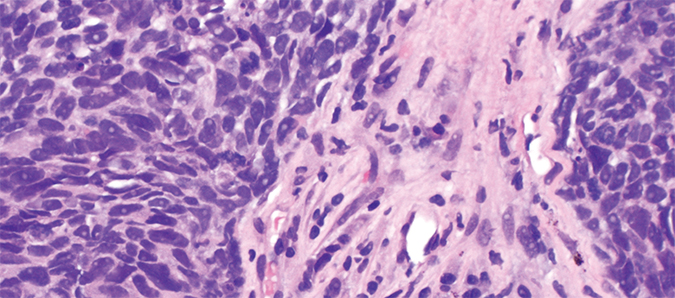JBC: A promiscuous inhibitor uncovers cancer drug targets
When signaling pathways within cells are triggered, proteins activate like a row of tumbling dominoes until the final protein influences some cellular function. In some tumors, multiple signaling pathways drive cell growth and survival; if one pathway ceases activity, another could continue driving cancerous behavior.
Several clinically approved kinase inhibitors originally were designed to block the function of individual signaling kinase proteins. Scientists now know that some of these inhibitors indiscriminately disrupt numerous proteins, which may allow them to kill certain tumors but also may inhibit some proteins unnecessarily, eliciting adverse effects.
To pinpoint the most therapeutically relevant kinase targets in cancer cells, a group of researchers at Harvard Medical School and the Dana Farber Cancer Institute in Boston, led by Nathanael Gray, has developed a method that exploits the multitargeted nature of a chemical inhibitor.
In a study published in the Journal of Biological Chemistry, Gray and colleagues identified key molecules that support the survival of a specific type of lung cancer. By analyzing how these cells respond to a cancer-killing kinase inhibitor with numerous targets, they showed that the anti-cancer effects likely were elicited by simultaneous inhibition of two signaling pathways. This approach could lead to development of cancer drugs that attack only the right targets.
 A micrograph of a non–small cell lung carcinoma shows nuclei in purple and cytoplasm in pink.Librepath/Wikimedia CommonsWhile studying various kinase inhibitors, Gray and his lab identified one, known as SM1-71, which binds to dozens of kinases, some of which support cell survival and growth.
A micrograph of a non–small cell lung carcinoma shows nuclei in purple and cytoplasm in pink.Librepath/Wikimedia CommonsWhile studying various kinase inhibitors, Gray and his lab identified one, known as SM1-71, which binds to dozens of kinases, some of which support cell survival and growth.
“It was sort of like a stick of dynamite and really could hit a lot of different targets,” Gray said.
In the JBC study, the researchers exposed several cancer cell types to SM1-71 and found that the drug was highly toxic to a lung cancer cell line with a mutation that activates many signaling pathways that drive cell growth. The inhibitor’s ability to kill these mutated cells suggested that targets in several pathways were being hit, Gray said.
To discover which of the many buttons pushed by SM1-71 elicited its anti-cancer effects, the researchers used Western blotting to narrow down which signaling proteins related to survival and growth were being blocked in cancer cells, revealing that proteins in two critical pathways were inhibited.
The authors then applied various kinase inhibitors to see if inhibiting any combination of the proteins in these pathways would replicate the cancer-killing effects of SM1-71. In the end, inhibiting MEK1/2 and IGF1R/INSR proteins at the same time demonstrated similar effects, suggesting that these are crucial targets in this lung cancer line, Gray said.
SM1-71 is likely not viable in humans because it binds to too many proteins and could cause collateral damage, Gray said. But uncovering its most important targets within specific pathways is valuable for designing drugs that can shut down multiple signaling pathways, which is necessary in some tumors.
“The next step would be to try to preserve the efficacy-driving targets while getting rid of targets that may be contributing to the toxicology,” Gray said.
Enjoy reading ASBMB Today?
Become a member to receive the print edition monthly and the digital edition weekly.
Learn moreGet the latest from ASBMB Today
Enter your email address, and we’ll send you a weekly email with recent articles, interviews and more.
Latest in Science
Science highlights or most popular articles

From the journals: JLR
Do lipid levels influence mortality? Unraveling cholesterol biosynthesis. Phospholipids promote toxoplasmosis. Read about recent papers on these topics.

Can a hair-loss drug prevent heart disease?
With the approved medication finasteride, researchers in Illinois may have found a new way to kill two birds with one stone.

These proteins have been secretly managing your cells
Scientists have long known that histones spool DNA and help regulate genes. They may be doing a lot more.

At the Salton Sea, uncovering the culprit of lung disease
Scientists have long suspected a link between the dust and poor respiratory health. According to recent findings, the prime suspect is a naturally occurring toxin.

From the journals: MCP
The importance of sharing proteomics data. Detecting nitrotyrosine-containing proteins. Analyzing yeast proteasomes. Read about these recent articles.

Using a network to snare the cause of kidney disease
A microfluidic device that mimics blood capillaries may help in early detection, and proper measures could reduce the risk of renal failures.

